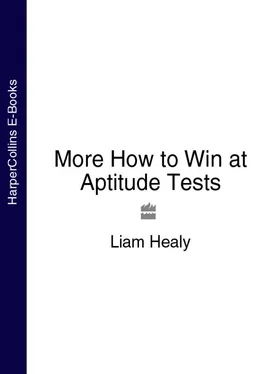Maximum Performance Tests
A maximum performance test looks at what you can actually do when you are trying your best and this is exactly what an aptitude or ability test is. Look at the following from a numerical aptitude test:
123 × 456 = ?
Clearly, if you do not put effort into answering this question, you will not get the answer right. Your gut feeling might produce an answer of about 500,000. This is not the correct answer, and if you put this down as the answer you would be wrong. If you tried harder you might eventually come up with the correct answer (56,088).
So, with tests of maximum performance, the questions do have right and wrong answers and so the results can be interpreted numerically with greater ease than typical performance tests.
One of the things we know about intellectual ability is that people who are rated as being more intelligent than others may be so because they can solve problems more quickly. It follows that tests of maximum performance, such as aptitude tests, usually have strict time limits.
If you sat a test that assessed your numerical skills, you may find that it would be called something like a ‘Numerical Aptitude’ test. Subsequently, you may sit a test that looks exactly the same but instead is called a ‘Numerical Ability’ test. They certainly look the same – but there is a difference.
In reality, they both measure numerical skills. Psychologists have known for a long time that intelligence, or intellectual ability, is composed of a number of separate facets. Generally, these areas are accepted as being linked to verbal, numerical, abstract, spatial and mechanical reasoning.
If we were only interested in, say, mechanical reasoning, we would refer to this very specific area as ‘aptitude’ or ‘specific ability’. Very often, a person’s scores on three tests – for example, verbal, numerical and abstract ability – are combined to produce an overall score. More rarely, because of the time involved, a test may have questions from all three.
When used in this combined way, a measure of a person’s overall general ability or general aptitude is obtained. Remember:
Ability= general aptitude or overall ability at verbal, numerical and abstract thinking.
Aptitude= specific ability, such as in verbal or numerical or abstract thinking.
This distinction is not so important for the average test taker, since you may simply be told to expect a test of numerical reasoning skill, so don’t worry too much about it.
It is important, though, not to confuse tests of ability and aptitude with tests of attainment. These assess what you have learnt, and are tests of knowledge not ability. Things like school or driving exams are tests of attainment rather than direct measures of ability.
Speed and Power tests represent different styles of test, rather than measuring different aptitudes or abilities; specifically, they describe the nature of the test questions themselves.
In a speed test, the items tend to be quite small in scope, very specific and often not too difficult. With speed tests it is how many questions the test taker can answer correctly that is important. A numerical aptitude test with speed items could look something like this; you can see how each question is very narrowly confined in terms of content:
123 + 456 = ?
987 – 654 = ?
567 × 123 = ?
In the case of a power test, the approach is quite different and much more emphasis is placed on presenting the test taker with a smaller number of more difficult or complex questions.
A numerical aptitude test with power items may look something like:
Brian is 6 cm taller than Kate and Kate is 2 cm taller than William. William is 1,680 cm tall. Andrew is taller than all three but not as tall as Marjorie.
Brian is taller than Andrew
a) true
b) false
c) can’t tell
Brian is 1,692 cm tall
a) true
b) false
c) can’t tell
Typically, speed tests contain a lot more items than power tests although they often have the same approximate time limit. Power tests tend to be used more at the graduate, professional or managerial level since their expanded format allows for more work-related content to be addressed.
APTITUDE AND REASONING ABILITY
Although reasoning ability does depend on some level of ‘raw’ or basic ability, aptitude and reasoning ability are two different things. Straightforward ability or aptitude is to do with the computational acts involved in solving a very specific test question – what you have to do is often clear, whether you can do it or not is quite a different matter. Reasoning ability is to do with knowing when to apply a certain computational act.
In the power and speed test examples above, the speed questions were to do with basic, raw numerical or mathematical ability. A very precise act of computation (for instance subtraction or multiplication) was clearly indicated by the format of the question. All you had to do was carry out the calculation.
With the power questions, it was not indicated which specific mathematical computation (for instance, addition or division) had to be carried out in order to reach a solution. The task you faced was to apply a more general problem solving approach – the problem being not ‘what is the answer?’ but ‘what do I have to do to work out how to reach the answer?’
Once you have established how to reach the answer, the final task itself is often a very simple process of mathematical calculation.
Brian is 1,692 cm tall
a) true
b) false
c) can’t tell
If William is 1,680 cm tall, Kate is 2 cm taller than William, and Brian is 6 cm taller than Kate then the answer must be:
1,680 cm + 2 cm + 6 cm = 1,688 cm.
So the statement that Brian is 1692 cm tall is false.
Notice how simple the mathematics was once we had worked out what to do. This is a good example of numerical reasoning ability or aptitude, rather than just straightforward numerical ability or aptitude. Furthermore, because the information is presented verbally, this is also a reasonable example of what verbal reasoning test items may look like. Power tests are more commonly found in the numerical and verbal domains but can also crop up in the mechanical, abstract and perceptual ability areas.

The other two commonest types of test are Work Samples and Job Simulations, although at first glance they do not look as we imagine tests to be.
A Work Sample test is exactly what its name implies – a sample of the work the candidate is required to do. These tend to be used widely in mechanical or practical areas of work. A common example is a typing test where the candidate has to type out some hand-written notes without making any errors within a given period of time. Another example is a fork-lift truck driver moving a set number of pallets from one place to another to within a certain degree of accuracy. If you are invited for a Work Sample test, the chances are you already have some skill in the area to begin with.
Job Simulations look similar to Work Samples and the two are often confused. However, whereas a Work Sample actually involves doing a sample of the activities carried out in the target job, a Job Simulation only simulates those activities involved in the target job.
Читать дальше













